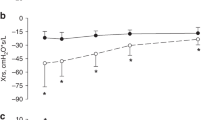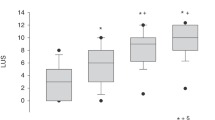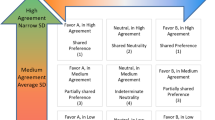Abstract
ABSTRACT: Changes in respiratory mechanics and timing produced by continuous negative extrathoracic pressure (CNEP) of −0.6 kPa were assessed in 18 infants recovering from neonatal respiratory distress syndrome. The median gestational age was 28 wk (range 24–36 wk). All infants were recruited before discharge from neonatal intensive care and were measured at a median postnatal age of 58 d (range 10–127 d) and a median weight of 2.67 kg (range 1.99–3.77 kg). All had been treated for respiratory distress syndrome; 11 were diagnosed as having chronic lung disease. At the time of the study, all infants were stable breathing room air. There was a significant decrease of the respiratory rate in all but one infant from 63.6 ± 10.0 to 49.3 ± 9.1 breaths per min (mean ± SD) during CNEP. This was predominantly due to a marked prolongation of the expiratory time. Passive respiratory mechanics were assessed using airway occlusion techniques. Whereas respiratory system compliance (Crs) did not change in the infants with a normal baseline measurement, there was a significant improvement of Crs in the 11 infants with low Crs values in atmosphere: In the latter, all of whom were very-low-birth-weight infants, Crs assessed by the multiple occlusion technique (mean ± SD) corrected for body weight in-creased from 7.9 ± 1.5 to 9.4 ± 1.9 mL·kPa−1. kg−1 in CNEP (p = 0.012). There was no consistent change in respiratory system resistance in this population of 18 infants. These preliminary results suggest that the beneficial effects of CNEP observed in clinical studies may be partially explained by its effects on respiratory mechanics and timing.
Similar content being viewed by others
Log in or create a free account to read this content
Gain free access to this article, as well as selected content from this journal and more on nature.com
or
Author information
Authors and Affiliations
Rights and permissions
About this article
Cite this article
Gappa, M., Costeloe, K., Southall, D. et al. Effect of Continuous Negative Extrathoracic Pressure on Respiratory Mechanics and Timing in Infants Recovering from Neonatal Respiratory Distress Syndrome. Pediatr Res 36, 364–372 (1994). https://doi.org/10.1203/00006450-199409000-00017
Received:
Accepted:
Issue date:
DOI: https://doi.org/10.1203/00006450-199409000-00017



